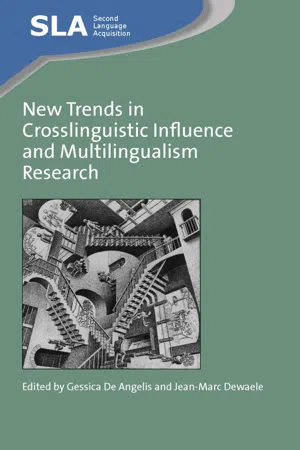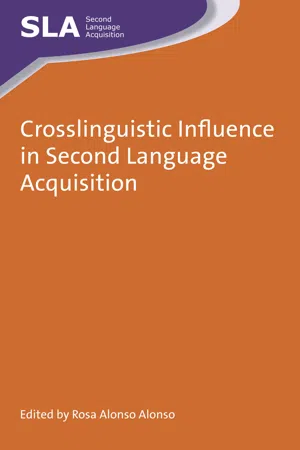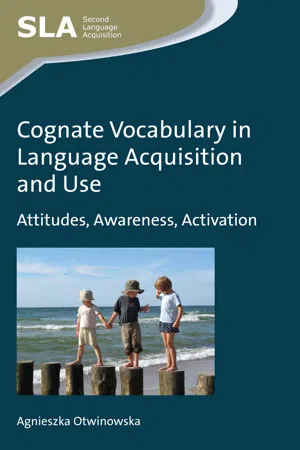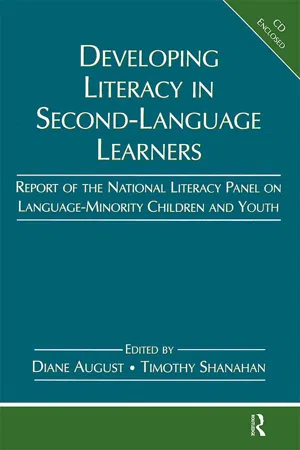Languages & Linguistics
Cognate
A cognate is a word that has a common origin with another word in a different language. Cognates often have similar meanings and spellings, and can be useful for language learners to recognize and remember vocabulary. For example, the English word "father" and the Spanish word "padre" are cognates.
Written by Perlego with AI-assistance
Related key terms
Related key terms
1 of 4
Related key terms
1 of 3
4 Key excerpts on "Cognate"
- Gessica De Angelis, Jean-Marc Dewaele(Authors)
- 2011(Publication Date)
- Multilingual Matters(Publisher)
Wode (1983, cited in Odlin 2006) suggested that learners need to notice ‘a crucial similarity’ between the native and the target language, whereas Odlin (1989: 77) stated that ‘similarities and dissimilarities in word forms, along with similarities and dissimilarities in word meanings, play a major role in how quickly a particular foreign language may be learned by speakers of another language’. What follows is that the existence of Cognate words in the learner’s L1, L2 and Ln may enhance the process of language learning when the learner is able to judge their communicative utility. Cognates are commonly defined as ‘words in different languages, which have descended from a common parent word’ (Schmitt, 1997: 209). However, as claimed by Otwinowska-Kasztelanic (2001) and Rusiecki (2002), the group of Cognates also comprises words borrowed from one language to another (e.g. computer and hamburger) or borrowed independently by some languages (e.g. sputnik and robot). Thus, Cognates should be understood as words that have descended from a common parent word, have been borrowed from Lx to Ly or have been borrowed independently by the two languages. Defined in such a way, Cognates exist in European languages both close and distant typologically (e.g. English: optimistic, computer, zebra; Polish: optymistyczny, komputer, zebra; German: optimistisch, Computer, Zebra). For instance, for Polish and English, the number of Cognates exceeds 2500 items, as noted by Otwinowska-Kasztelanic (2007, 2009). It is not difficult to notice that Latin- and Greek-based words are also quite common in formal styles and registers used by educated European speakers in their L1. As for English, Nation and Meara (2002: 49) point out that ‘almost all the basic Anglo-Saxon words have parallel forms based on Latin and Greek, which are used in particular, specialist discourse’- Rosa Alonso Alonso(Author)
- 2016(Publication Date)
- Multilingual Matters(Publisher)
This chapter first discusses what Cognates are and are not, depending on the research context. The chapter goes on to examine empirical research on Cognate facilitation in behavioural research in psycholinguistics, recent electrophysiological research and classroom-based L2 research; this section also summarises empirical findings in frequency and genre-based L2 lexical testing. The second half of the chapter considers the possible mechanisms driving Cognate facilitation and examines the effectiveness of classroom intervention in situations where Cognate recognition is not automatic or when L2 lexemes are inaccurately linked with L1 lemmas as a result of overgeneralised L1-to-L2 transfer.What are Cognates?Related languages feature a certain proportion of word pairs in their vocabularies which trace their origin to the same word in their ancestor language. Thus, the Finnish and Hungarian words for ‘water’, vesi and víz , respectively, are both derived from the reconstructed Proto-Uralic word *weti (Janhunen, 1998). Word pairs of this type are called Cognates. Apart from word pairs directly descended from an ancestral form, the term ‘Cognate’ could be extended to include instances of a language borrowing vocabulary from another language, as is the case with Serbo-Croatian fotelja (‘armchair’), from French fauteuil. Similarly, the term would encompass words which two languages, related or not, borrowed from a third language (to which they may or may not be related). For example, Hungarian and Malay both feature a version of the Latin word tr ā ns ā cti ō (‘transaction’), the former as tranzakció and the latter as transaksi . In some circles, the term ‘Cognate’ is extended to even more recent borrowings between genetically unrelated languages, as has become common in today’s world of global communication, for instance, Japanese サーモスタット /saː mosɯ tatto/ from English thermostat /ˈθɚ moʊ stæt / (Shirai, 2012).There are other ways in which two languages may end up with pairs of similar-sounding words with roughly the same meanings. As is often remarked, the connection between the form of a word and its meaning is typically arbitrary (e.g. Modern Greek represents ‘water’ as νερό /neˈɾ o/, Mandarin as 水 shu ǐ /ʂ weɪ̯/, and Ojibwe as nibi /nɪˈ bɪ / (Nichols & Nyholm, 2002)). However, iconicity frequently creates some crosslinguistic similarities among words, as in onomatopoeia (e.g. the sound of a dog’s barking is rendered as /ˈ hav ˈ hav/ in Hebrew, bow-vow in English, au-au in Basque and भऊभऊ /bʱ a’uː bʱ a’uː / in Hindi). Similarly, a subtler process such as sound symbolism can result in crosslinguistic resemblances, as when the prosody of independently derived words for ‘butterfly’ captures the fluttering motion of a butterfly’s wings (see Beeman, 2000), as in רפרפ /paʁˈ paʁ / in Hebrew and farfalla in Italian. Iconic words that resemble each other are not considered Cognates. Likewise, pairs of similar words in unrelated languages owing their existence to the nature of the language acquisition process and the physiology and anatomy of the infant speech tract are not Cognates. Typical examples are kinship terms, especially the words for ‘mother’ and ‘father’. Thus, the Persian word for ‘daddy’ or ‘papa’, bɒˈ bɒ / and its Mandarin counterpart 爸爸 /pa˥˩- eBook - ePub
Cognate Vocabulary in Language Acquisition and Use
Attitudes, Awareness, Activation
- Agnieszka Otwinowska(Author)
- 2015(Publication Date)
- Multilingual Matters(Publisher)
Since learning consists in relating new knowledge to what we already know, or can easily associate with something known, Cognate vocabulary seems ideal to learn in a fast and effortless way (Ringbom, 2007). For the learner, the mere presence of Cognate forms should be the most salient feature of the newly learnt language. Moreover, there would be no difference, whether the crosslinguistically similar forms are true Cognates deriving from linguistic genealogy or non-genetic Cognates deriving from language contact (Jarvis, 2009; see Chapter 4). This chapter focuses on the role of Cognates in second language learning. It points to the differences between the assumed role of Cognates in SLA and how, surprisingly, some language learners tend not to be aware of Cognates in the target language. Finally, conclusions are drawn from the studies presented, which point to certain methodological flaws of SLA research on Cognates. The Assumed Role of Cognates in Language Acquisition In SLA the presence of crosslinguistic lexical similarity is considered to be a real asset. It is claimed that, apart from the obvious disadvantages of false friends, ‘learners will find one language far easier to learn than another if the one language shows many lexical similarities with their native language and the other does not’ (Odlin, 1989: 79). The very idea that similarities and differences in word forms and word meanings play a role in how quickly a particular foreign language may be learned by speakers of another language has been recognised for at least a century. Already in 1899 Sweet observed that [m]astering the vocabulary of most European languages means simply learning to recognize a number of old friends under slight disguises, and making a certain effort to learn a residue of irrecognizable words, which, however, offer less difficulty than they otherwise would through being imbedded in a context of familiar words - eBook - ePub
Developing Literacy in Second-Language Learners
Report of the National Literacy Panel on Language-Minority Children and Youth
- Diane August, Timothy Shanahan(Authors)
- 2017(Publication Date)
- Routledge(Publisher)
Saville-Troike (1984) conducted a retrospective analysis to explain why a group of children who began their school year with an equal lack of proficiency in English were at different levels of achievement in English-medium instruction by the end of 1 year. The sample included 19 children in Grades 2 through 6 who were native speakers of one of seven languages: Japanese, Korean, Hebrew, Arabic, Spanish, Icelandic, or Polish. Criteria for subject selection were (a) very little or no prior exposure to English, (b) coming from a well-educated family, and (3) initial literacy in the native language. The principal finding from this study is relevant to the question of the relationship between the level of second-language oral language proficiency (including vocabulary knowledge) and reading comprehension (addressed in previous chapters in Part I). With respect to the influence of first-language vocabulary knowledge on second-language vocabulary, Saville-Troike identified transfer in the strategies the students used to determine the meanings of unknown words. Specifically, in an analysis of different types of errors made on multiple-choice vocabulary tests, she observed that speakers of Western European languages selected alternatives with a stem similar to that of the target word. In other words, they searched for Cognates. In contrast, Japanese children were more likely to choose an alternative that had the same sequence of two or more letters in any position within the word, including the end of a syllable or a suffix. The author speculates that the Japanese first-language students employed “a strategy which may be similar to conducting a visual search for a common ‘radical’ in a Chinese character” (p. 214). Because letter sequences in these positions do not provide the same kind of clue to the meaning of a word as is found in the stem, these findings suggest that speakers of closely related languages have a tool at their disposal not available to students whose first language is typologically distant from the target language.Cognate awareness and its relationship to reading comprehension was the focus of an important study by Nagy et al. (1993). Within a sample of 74 Spanish-English bilingual, biliterate fourth, fifth, and sixth graders from two predominantly Hispanic urban elementary schools, the authors sought to determine (a) whether there was any relationship between students’ knowledge of words and concepts in Spanish and their understanding of vocabulary in an English text, and (b) whether lexical transfer (if it occurred) was mediated by students’ ability to recognize Cognates.Students read four expository texts at the Grade 4 level that contained numerous clear Spanish–English Cognates. Comprehension of the passages was assessed through a multiple-choice test, which included 34 target Cognates from the passages. Students demonstrated their level of Cognate awareness through a Cognate-circling task in which they were given a copy of the four experimental passages and asked (after being given a brief explanation of what a Cognate is) to circle all the Cognates they found.
Index pages curate the most relevant extracts from our library of academic textbooks. They’ve been created using an in-house natural language model (NLM), each adding context and meaning to key research topics.
Explore more topic indexes
Explore more topic indexes
1 of 6
Explore more topic indexes
1 of 4



